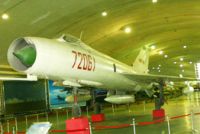Difference between revisions of "CIIC:Selected anniversaries/November 11"
From Wiki China org cn
imported>Ciic (Created page with 'right|200px|The F-8 is a supersonic fighter with a single seat and twin engines. It made its maiden flight on July 5, 1969. 1949: The headquarters of the Ai...') |
imported>Ciic |
||
| Line 1: | Line 1: | ||
[[File:kj4.jpg|right|200px|The F-8 is a supersonic fighter with a single seat and twin engines. It made its maiden flight on July 5, 1969. ]] | [[File:kj4.jpg|right|200px|The F-8 is a supersonic fighter with a single seat and twin engines. It made its maiden flight on July 5, 1969. ]] | ||
| − | [[1949]]: The headquarters of the Air Force of the [[ | + | |
| + | [[1949]]: The headquarters of the Air Force of the Chinese [[People's Liberation Army]] (PLA) was set up in [[Beijing]], signifying that the Air Force had officially become a branch of the PLA armed services. | ||
[[1989]]: The '''[[China Aviation Museum]]''' opened to the public. | [[1989]]: The '''[[China Aviation Museum]]''' opened to the public. | ||
[[1994]]: The widest broadband seismograph in the world was developed in China. The''' [[JCZ-1 ultra-broadband seismometer]]''', as it was called, is extremely sensitive and able to sense a wide array of scopes, from high-frequency seismic waves to wide frequencies of solid tides. | [[1994]]: The widest broadband seismograph in the world was developed in China. The''' [[JCZ-1 ultra-broadband seismometer]]''', as it was called, is extremely sensitive and able to sense a wide array of scopes, from high-frequency seismic waves to wide frequencies of solid tides. | ||
Revision as of 02:08, 10 November 2009
1949: The headquarters of the Air Force of the Chinese People's Liberation Army (PLA) was set up in Beijing, signifying that the Air Force had officially become a branch of the PLA armed services.
1989: The China Aviation Museum opened to the public.
1994: The widest broadband seismograph in the world was developed in China. The JCZ-1 ultra-broadband seismometer, as it was called, is extremely sensitive and able to sense a wide array of scopes, from high-frequency seismic waves to wide frequencies of solid tides.
